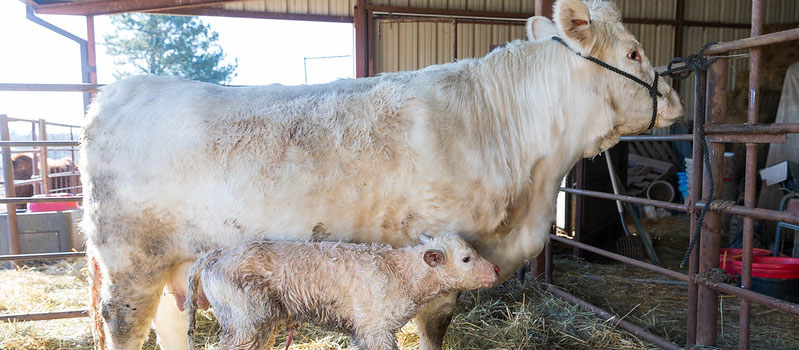
After a cow calves, it is important that the calf gets up to nurse to receive colostrum. | Download this photo
Cattle Chat: Commercial colostrum replacements
K-State beef cattle experts offer insight on using commercial colostrum replacements
At a glance: K-State beef cattle experts discuss the benefits of using commercial colostrum replacements.
More information: Bob Larson, 785-532-4257, rlarson@vet.k-state.edu
Photo: https://www.flickr.com/photos/ksrecomm/53483354755
Related: K-State Beef Cattle Institute (podcast)
Jan. 30, 2024
By Jessica Jensen, K-State Research and Extension news service
MANHATTAN, Kan. — Veterinarians in Kansas State University’s Beef Cattle Institute have emphasized the importance of getting calves up to nurse shortly after birth so that they receive colostrum, which gives passive immunity to the calf.
On a recent Cattle Chat podcast, the experts discussed commercial colostrum replacements and the risks associated with commercial products. Colostrum is the first milk produced from a cow after birth and is rich in nutrients and antibodies.
K-State veterinarian Brad White said if a cow has a difficult birth, it is important that the calf receives colostrum. Sometimes this means having to use a commercial colostrum replacer.
“There are a couple options a producer has if a cow had a difficult birth and the calf isn’t getting up to vigorously suckle,” K-State veterinarian Bob Larson said. “The producer will have to give the calf colostrum; if not from the cow, then from somewhere else.”
Larson recommends that producers buy colostrum replacer from a store. One problem that can arise if cow colostrum is obtained from a dairy or an outside herd is diseases that can be passed through the colostrum. The main two diseases are Bovine leukosis virus and Johne's disease.
“My recommendation is don’t go outside your herd for colostrum,” Larson said. “Bank your own colostrum from your herd or use the commercial colostrum replacements.”
Commercial colostrum replacements are not as good as real colostrum. Larson suggests using the colostrum replacements when the calf is not likely to suckle within a few hours of birth.
White said there are risks to the calf, but an even bigger risk is not giving colostrum. When giving colostrum, he said, administering it correctly is important.
“When giving colostrum, know what you are doing, what you are feeling for, make sure you are in the right spot and that the calf is positioned correctly,” White said.
Larson added that when using the tube feeder, it is important that the feeder is used correctly to make sure the colostrum is put in the stomach and not the lungs.
“There is some danger with administering products with a tube feeder,” Larson said. “Make sure you are gentle and don’t rush into it. It can be done wrong if not careful.”
For those who are not experienced in administering colostrum, ask someone to help and watch to receive instructions until you feel comfortable administering it alone. It is important to avoid cross contamination, so clean tools thoroughly afterwards.
“There is no real negative of using commercial colostrum replacement, but don’t rush in and give the replacement to a calf that is doing pretty well,” Larson said.
To hear the full discussion, listen to Cattle Chat podcast online or through your preferred streaming platform.
***

K‑State Research and Extension is a short name for the Kansas State University Agricultural Experiment Station and Cooperative Extension Service, a program designed to generate and distribute useful knowledge for the well‑being of Kansans. Supported by county, state, federal and private funds, the program has county extension offices, experiment fields, area extension offices and regional research centers statewide. Its headquarters is on the K‑State campus in Manhattan. For more information, visit www.ksre.ksu.edu. K-State Research and Extension is an equal opportunity provider and employer.